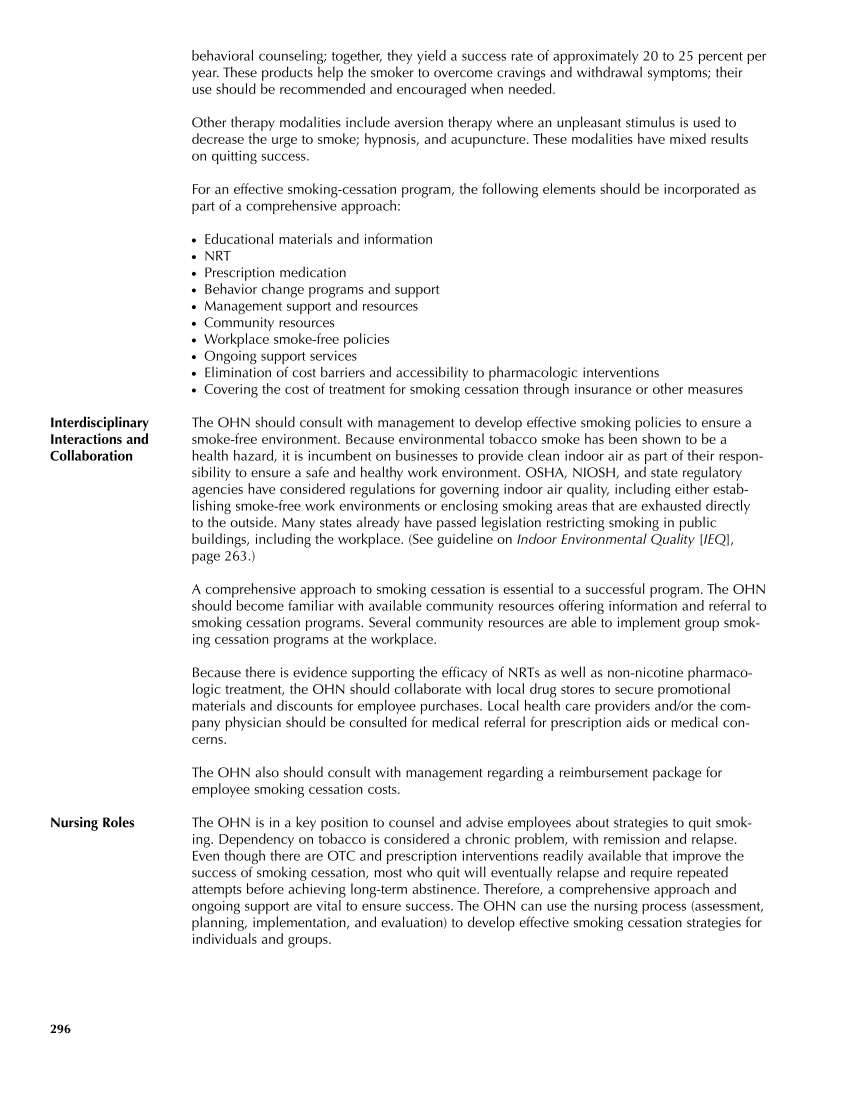behavioral counseling together, they yield a success rate of approximately 20 to 25 percent per year. These products help the smoker to overcome cravings and withdrawal symptoms their use should be recommended and encouraged when needed. Other therapy modalities include aversion therapy where an unpleasant stimulus is used to decrease the urge to smoke hypnosis, and acupuncture. These modalities have mixed results on quitting success. For an effective smoking-cessation program, the following elements should be incorporated as part of a comprehensive approach: ● Educational materials and information ● NRT ● Prescription medication ● Behavior change programs and support ● Management support and resources ● Community resources ● Workplace smoke-free policies ● Ongoing support services ● Elimination of cost barriers and accessibility to pharmacologic interventions ● Covering the cost of treatment for smoking cessation through insurance or other measures The OHN should consult with management to develop effective smoking policies to ensure a smoke-free environment. Because environmental tobacco smoke has been shown to be a health hazard, it is incumbent on businesses to provide clean indoor air as part of their respon- sibility to ensure a safe and healthy work environment. OSHA, NIOSH, and state regulatory agencies have considered regulations for governing indoor air quality, including either estab- lishing smoke-free work environments or enclosing smoking areas that are exhausted directly to the outside. Many states already have passed legislation restricting smoking in public buildings, including the workplace. (See guideline on Indoor Environmental Quality [IEQ], page 263.) A comprehensive approach to smoking cessation is essential to a successful program. The OHN should become familiar with available community resources offering information and referral to smoking cessation programs. Several community resources are able to implement group smok- ing cessation programs at the workplace. Because there is evidence supporting the efficacy of NRTs as well as non-nicotine pharmaco- logic treatment, the OHN should collaborate with local drug stores to secure promotional materials and discounts for employee purchases. Local health care providers and/or the com- pany physician should be consulted for medical referral for prescription aids or medical con- cerns. The OHN also should consult with management regarding a reimbursement package for employee smoking cessation costs. Nursing Roles The OHN is in a key position to counsel and advise employees about strategies to quit smok- ing. Dependency on tobacco is considered a chronic problem, with remission and relapse. Even though there are OTC and prescription interventions readily available that improve the success of smoking cessation, most who quit will eventually relapse and require repeated attempts before achieving long-term abstinence. Therefore, a comprehensive approach and ongoing support are vital to ensure success. The OHN can use the nursing process (assessment, planning, implementation, and evaluation) to develop effective smoking cessation strategies for individuals and groups. 296 Interdisciplinary Interactions and Collaboration
Purchased from OEM Press by (ge corporate access). (C) 2013 OEM Health Information, Inc. All rights reserved.












































































































































































































































































































































































































































